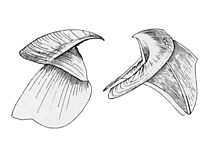en
names in breadcrumbs


Histioteuthis is a genus of squid commonly known as ‘cockeyed’ squids with approximately fifteen extantspecies having a circumglobal distribution from the subarctic to the subantarctic first described by Férussac in 1834 (Voss et al., 1998). Their distribution across a wide range of surface conditions is because they are generally found in the mesopelagic (200-1000 m) where conditions are fairly constant. Species exhibit diel vertical migration to the epipelagicin order tofeed at night with a diet consisting of crustaceans and fish then return to depth during the day. The genus is mainly characterized by their dimorphic eye sizes in both males and females where the left eye measures about twice as large as the right eye in diameter along with different pigmentation (Thomas et al., 2017). Thought to adjust for variable light intensity between the mesopelagic and epipelagic, dimorphic eye sizes were shown as an adaptation to two different light sources found in the mesopelagic: sunlight from above and bioluminescence. The body of most species consists of weak musculature with a relatively short mantle and long arms. Studies have shown that the average Histioteuthis sp. size (up to 33 cm.) increases with depth suggesting ontogenetic migration to deeper waters (Quetglas, 2010).

Histioteuthis is a genus of squid in the family Histioteuthidae. It goes by the common name cock-eyed squid, because in all species the right eye is normal-sized, round, blue and sunken; whereas the left eye is at least twice the diameter of the right eye, tubular, yellow-green, faces upward, and bulges out of the head.
In 2017, researchers at Duke University established that Histioteuthis uses its larger eye to see ambient sunlight, and its smaller eye to detect bioluminescence from prey animals.[2]
The name is composed of the Greek histion (ἱστίον, "sail", a large webbed membrane between six of the arms, in some species) and teuthis ("squid").[3][4]
The genus contains bioluminescent species.[5]
 Beak of Histioteuthis bonnellii
Beak of Histioteuthis bonnellii Histioteuthis is a genus of squid in the family Histioteuthidae. It goes by the common name cock-eyed squid, because in all species the right eye is normal-sized, round, blue and sunken; whereas the left eye is at least twice the diameter of the right eye, tubular, yellow-green, faces upward, and bulges out of the head.
In 2017, researchers at Duke University established that Histioteuthis uses its larger eye to see ambient sunlight, and its smaller eye to detect bioluminescence from prey animals.
The name is composed of the Greek histion (ἱστίον, "sail", a large webbed membrane between six of the arms, in some species) and teuthis ("squid").
The genus contains bioluminescent species.